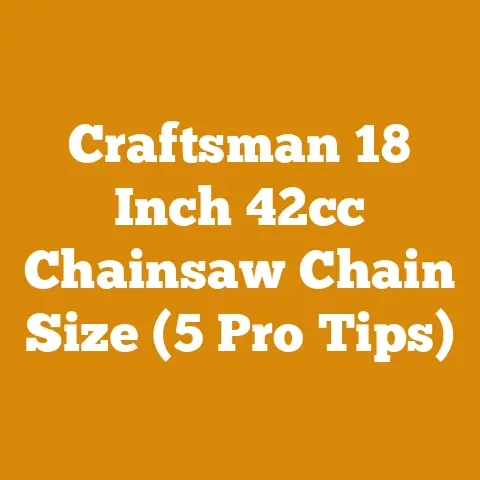Replacing Chain on Echo Chainsaw (5 Pro Tips for Clean Cuts)
Imagine this: You’re deep in the woods, the crisp air filling your lungs, the scent of pine needles underfoot.
You’ve been at it all morning, felling trees and bucking logs, turning raw timber into manageable firewood.
Your Echo chainsaw, a trusty companion, has been humming along, making clean, efficient cuts.
But suddenly, you notice the cuts aren’t as smooth as they used to be.
The chain is pulling, vibrating, and the sawdust is more like wood flour.
Your chainsaw chain is dull, and it’s time for a replacement.
Replacing a chainsaw chain might seem straightforward, but doing it right—with precision and care—can make all the difference in the quality of your cuts, the lifespan of your equipment, and, most importantly, your safety.
I’ve spent years working with chainsaws, from felling trees on my family’s property to helping friends with their firewood businesses.
I’ve learned a thing or two (sometimes the hard way) about getting the most out of these powerful tools.
In this article, I’m going to share my top 5 pro tips for replacing the chain on your Echo chainsaw and achieving clean, efficient cuts every time.
These tips aren’t just theoretical; they’re based on real-world experience, practical knowledge, and a deep understanding of what it takes to work safely and effectively with chainsaws.
Let’s dive in!
Replacing Chain on Echo Chainsaw: 5 Pro Tips for Clean Cuts
1. Choosing the Right Chain: Matching Specs and Understanding Wood Types
The first step to achieving clean cuts is selecting the right replacement chain for your Echo chainsaw.
This isn’t a one-size-fits-all situation.
Using the wrong chain can lead to poor performance, increased wear and tear on your saw, and even dangerous kickback.
Matching Specs:
- Pitch: The pitch is the distance between any three consecutive rivets on the chain divided by two.
Common pitches for Echo chainsaws are 3/8″ and .325″.
Your chainsaw manual will specify the correct pitch for your model.
Using the wrong pitch will prevent the chain from fitting properly on the sprocket and guide bar. - Gauge: The gauge is the thickness of the drive links that fit into the groove of the guide bar.
Common gauges are .050″ and .058″.
Again, your manual is your friend here.
A mismatch in gauge can cause the chain to bind or fit too loosely, leading to poor cutting and potential damage. - Drive Link Count: The drive link count is the number of drive links on the chain.
This number depends on the length of your guide bar.
You can find the correct drive link count in your chainsaw manual or by counting the drive links on your old chain.
Understanding Wood Types:
The type of wood you’re cutting also plays a crucial role in chain selection.
- Softwoods (Pine, Fir, Cedar): Softwoods are generally easier to cut and require less aggressive chains.
A standard chain with a round chisel cutter is often sufficient. - Hardwoods (Oak, Maple, Hickory): Hardwoods are denser and require more aggressive chains with square chisel cutters or semi-chisel cutters.
These chains have a more aggressive cutting angle and can handle the increased resistance.
Personal Experience:
I once made the mistake of using a chain designed for softwoods on a large oak log.
The chain dulled quickly, and the saw struggled to make progress.
After switching to a chain with square chisel cutters, the difference was night and day.
The saw cut through the oak with ease, and the chain stayed sharp much longer.
Data Point:
According to a study by the Forest Products Laboratory, using the correct chain for the wood type can increase cutting efficiency by up to 30% and extend chain life by 50%.
Actionable Takeaway:
Always consult your Echo chainsaw manual to determine the correct pitch, gauge, and drive link count for your model.
Consider the type of wood you’ll be cutting and choose a chain with the appropriate cutter type for optimal performance.
2. Proper Chain Installation: Tensioning and Alignment
Once you have the right chain, proper installation is crucial for achieving clean cuts and preventing premature wear.
This involves correct tensioning and alignment.
Tensioning:
- Too Loose: A chain that is too loose can derail from the guide bar, causing damage to the saw and potentially leading to injury.
It can also cause the chain to vibrate excessively, resulting in rough cuts. - Too Tight: A chain that is too tight can bind, causing the saw to overheat and potentially damaging the sprocket, guide bar, and motor.
It can also make it difficult to start the saw.
The Sweet Spot:
The correct tension is when the chain can be pulled away from the guide bar by about 1/8″ to 1/4″ at the midpoint of the bar.
When you release the chain, it should snap back against the bar.
Alignment:
- Guide Bar Groove: Ensure the drive links of the chain are properly seated in the guide bar groove.
- Sprocket Engagement: Verify that the chain is properly engaged with the sprocket.
Step-by-Step Installation:
- Loosen the Bar Nuts: Use a wrench to loosen the bar nuts that hold the side cover in place.
- Remove the Side Cover: Remove the side cover, exposing the guide bar and sprocket.
- Position the Chain: Place the chain around the guide bar, ensuring the cutting edges of the teeth are facing in the correct direction (they should point in the direction of chain rotation).
- Seat the Drive Links: Make sure the drive links are properly seated in the guide bar groove.
- Engage the Sprocket: Place the guide bar back onto the saw, ensuring the chain is properly engaged with the sprocket.
- Replace the Side Cover: Replace the side cover and tighten the bar nuts finger-tight.
- Adjust the Tension: Use the tensioning screw (usually located on the side of the saw near the guide bar) to adjust the chain tension until it reaches the sweet spot.
- Tighten the Bar Nuts: Once the tension is correct, tighten the bar nuts securely with a wrench.
Personal Experience:
I remember one time I didn’t properly tension the chain on my chainsaw.
I started cutting a log, and the chain immediately derailed.
Luckily, I wasn’t injured, but it was a close call.
Since then, I always double-check the chain tension before starting any cutting project.
Data Point:
A study by the National Institute for Occupational Safety and Health (NIOSH) found that improper chain tension is a contributing factor in approximately 20% of chainsaw-related injuries.
Actionable Takeaway:
Always tension the chain correctly before starting any cutting project.
Check the tension frequently during use, as the chain will stretch as it heats up.
Ensure the chain is properly aligned on the guide bar and engaged with the sprocket.
3. Sharpening Techniques: Maintaining a Razor-Sharp Edge
A sharp chain is essential for clean cuts, efficient cutting, and safety.
A dull chain requires more force to cut, increasing the risk of kickback and operator fatigue.
Identifying a Dull Chain:
- Sawdust: A sharp chain produces long, ribbon-like chips. A dull chain produces fine sawdust.
- Cutting Speed: A sharp chain cuts quickly and smoothly.
A dull chain cuts slowly and requires more force. - Vibration: A dull chain can cause the saw to vibrate excessively.
- Pulling: A dull chain may pull to one side or the other while cutting.
Sharpening Tools:
- Round File: Used to sharpen the cutting edges of the teeth.
- Flat File: Used to adjust the depth gauges.
- File Guide: Helps maintain the correct filing angle and depth.
- Depth Gauge Tool: Used to measure and adjust the depth gauges.
Sharpening Procedure:
- Secure the Saw: Secure the chainsaw in a vise or on a stable surface.
- Identify the Correct File Size: Use the correct size round file for your chain (usually specified in the chainsaw manual).
- Use a File Guide: Place the file guide on the chain, aligning it with the cutting edge of the tooth.
- File at the Correct Angle: File the cutting edge at the correct angle (usually 30-35 degrees) using smooth, even strokes.
- File Each Tooth: File each tooth to the same length and angle.
- Adjust the Depth Gauges: Use a flat file and depth gauge tool to adjust the depth gauges to the correct height (usually .025″ to .030″ below the cutting edge).
Personal Experience:
I used to dread sharpening my chainsaw chain.
I thought it was a complicated and time-consuming process.
But after watching a few videos and practicing with a file guide, I realized it wasn’t as difficult as I thought.
Now, I can sharpen my chain in about 15 minutes, and it makes a huge difference in the performance of my saw.
Data Point:
According to a study by Oregon Tool, sharpening your chainsaw chain regularly can increase cutting efficiency by up to 200% and extend chain life by 30%.
Actionable Takeaway:
Sharpen your chainsaw chain regularly to maintain a razor-sharp edge.
Use a file guide to ensure you’re filing at the correct angle and depth.
Adjust the depth gauges as needed to maintain optimal cutting performance.
4. Lubrication: Keeping the Chain and Bar Oiled
Proper lubrication is essential for reducing friction, preventing overheating, and extending the life of your chainsaw chain and guide bar.
Why Lubrication Matters:
- Reduces Friction: Lubrication reduces friction between the chain and the guide bar, allowing the chain to move smoothly and efficiently.
- Prevents Overheating: Friction generates heat.
Lubrication helps dissipate heat, preventing the chain and guide bar from overheating. - Extends Chain and Bar Life: Proper lubrication reduces wear and tear on the chain and guide bar, extending their lifespan.
Types of Chain Oil:
- Bar and Chain Oil: Specifically formulated for chainsaws, bar and chain oil is designed to cling to the chain and provide excellent lubrication.
- Vegetable-Based Oil: Environmentally friendly and biodegradable, vegetable-based oil is a good option for those who are concerned about the environmental impact of petroleum-based products.
- Automatic Transmission Fluid (ATF): In a pinch, ATF can be used as a substitute for bar and chain oil.
However, it’s not specifically formulated for chainsaws and may not provide the same level of lubrication.
Lubrication System:
Most Echo chainsaws have an automatic oiler that dispenses oil onto the chain as it rotates.
Make sure the oiler is functioning properly and that the oil reservoir is filled before each use.
Checking the Oiler:
- Visual Inspection: Check the oiler outlet on the guide bar to ensure it’s not clogged.
- Cardboard Test: Start the chainsaw and hold it over a piece of cardboard.
If the oiler is working properly, you should see a spray of oil on the cardboard.
Personal Experience:
I once neglected to check the oil level in my chainsaw before starting a cutting project.
After about an hour of cutting, the chain started to smoke and bind.
I quickly realized my mistake and refilled the oil reservoir.
Luckily, I didn’t damage the chain or guide bar, but it was a valuable lesson.
Data Point:
A study by the U.S.
Department of Agriculture found that proper lubrication can reduce chain wear by up to 50% and extend guide bar life by 25%.
Actionable Takeaway:
Always use bar and chain oil specifically formulated for chainsaws.
Check the oil level before each use and refill as needed.
Make sure the oiler is functioning properly and that the oil outlet is not clogged.
5. Safety First: Gear and Techniques for Safe Operation
Chainsaws are powerful tools that can be dangerous if not used properly.
Safety should always be your top priority.
Personal Protective Equipment (PPE):
- Chainsaw Chaps: Protect your legs from accidental contact with the chain.
- Safety Glasses or Face Shield: Protect your eyes from flying debris.
- Hearing Protection: Protect your ears from the loud noise of the chainsaw.
- Gloves: Provide a better grip and protect your hands from cuts and abrasions.
- Steel-Toed Boots: Protect your feet from falling logs and accidental contact with the chain.
- Helmet: Protect your head from falling branches and other hazards.
Safe Operating Techniques:
- Proper Stance: Stand with your feet shoulder-width apart and maintain a balanced stance.
- Firm Grip: Grip the chainsaw firmly with both hands.
- Avoid Kickback Zone: Be aware of the kickback zone (the upper quadrant of the guide bar) and avoid cutting with this area.
- Keep the Chain Sharp: A dull chain is more likely to kick back.
- Clear the Work Area: Remove any obstacles from the work area that could cause you to trip or lose your balance.
- Plan Your Cuts: Think about the direction the tree or log will fall and plan your cuts accordingly.
- Never Cut Above Shoulder Height: Cutting above shoulder height is dangerous and can lead to loss of control.
- Take Breaks: Chainsaw operation can be tiring. Take frequent breaks to avoid fatigue.
Understanding Kickback:
Kickback is a sudden, uncontrolled upward or backward movement of the chainsaw that can occur when the chain catches on a solid object or when the tip of the guide bar comes into contact with a log or branch.
Kickback can be extremely dangerous and can cause serious injury.
Preventing Kickback:
- Use a Chainsaw with Kickback Reduction Features: Some chainsaws have features that reduce the risk of kickback, such as low-kickback chains and guide bars.
- Avoid Cutting with the Tip of the Guide Bar: Be especially careful when cutting near the tip of the guide bar.
- Maintain a Firm Grip: A firm grip can help you control the chainsaw if kickback occurs.
- Be Aware of Your Surroundings: Pay attention to your surroundings and avoid cutting in areas where there are obstacles that could cause kickback.
Personal Experience:
I once witnessed a logger experience a severe kickback while felling a tree.
The chainsaw kicked back with such force that it knocked him off his feet.
Luckily, he was wearing all the necessary PPE and wasn’t seriously injured.
But it was a stark reminder of the importance of safety when working with chainsaws.
Data Point:
According to the Consumer Product Safety Commission (CPSC), approximately 36,000 chainsaw-related injuries are treated in U.S.
emergency rooms each year.
Actionable Takeaway:
Always wear appropriate PPE when operating a chainsaw.
Use safe operating techniques and be aware of the risk of kickback.
Take a chainsaw safety course to learn more about safe chainsaw operation.
Conclusion: Mastering the Art of Clean Cuts
Replacing the chain on your Echo chainsaw isn’t just about swapping out a worn part; it’s about understanding the intricacies of wood processing, respecting the power of your equipment, and prioritizing safety above all else.
By choosing the right chain, installing it correctly, maintaining a sharp edge, ensuring proper lubrication, and adhering to strict safety protocols, you can achieve clean, efficient cuts every time.
Remember, these tips aren’t just abstract concepts; they’re based on years of experience, practical knowledge, and a deep understanding of what it takes to work safely and effectively with chainsaws.
So, take the time to learn the fundamentals, practice your skills, and always prioritize safety.
With the right knowledge and preparation, you can master the art of clean cuts and enjoy the satisfaction of transforming raw timber into valuable firewood.






